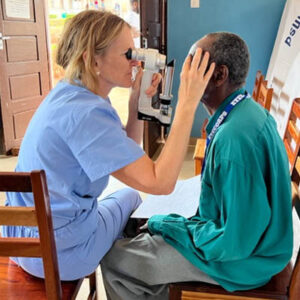Refractive
April 2022
by Ellen Stodola
Editorial Co-Director
With keratoconus, it’s important to diagnose patients as early as possible in order to treat them before more drastic procedures, like a corneal transplant, might be needed. Crosslinking has aided in the early treatment of keratoconus, and the use of genetic testing is another tool for doctors to add to their armamentarium. Eric Donnenfeld, MD, and Elizabeth Yeu, MD, discussed AvaGen, a test from Avellino that can be used to assess genetic risk for keratoconus and other corneal dystrophies.
Genetic testing is one of the newest topics in all of medicine, Dr. Donnenfeld said. Looking at genetic risk factors gives doctors a heads up on better management. Being able to tell if a patient is at risk for a disease allows physicians to diagnose and potentially start therapy earlier. “Keratoconus has been one of the most difficult diseases I’ve treated in the course of my career,” Dr. Donnenfeld said. “Now that we have genetic testing to go along with crosslinking, not only can we diagnose it sooner, but we can treat it sooner and prevent it from progressing.”
Dr. Yeu finds genetic testing a great tool for keratoconus screening for a variety of patients, such as those in which refractive screenings are not straightforward and family members of known keratoconus patients. She uses this testing in about one of every four refractive screenings.
Where does it fit into testing and treatment?
Keratoconus is polygenic, meaning there are a lot of genetic variations, so you can’t just look at one gene type, Dr. Donnenfeld said. “You have to look at the entire genetic pool and correlate this with other risk factors. Having the genetic testing allows me to know who’s at risk to counsel them,” he said.
When someone has keratoconus, family members are at increased risk. Testing siblings and children of keratoconus patients allows them to understand the risks associated with genetic predisposition and how they should be followed. “I find it extremely disconcerting when someone has had keratoconus for several years and the first time I see them, they’re ready for a corneal transplant,” Dr. Donnenfeld said. “I want to diagnose these patients earlier before they get to this stage.”
Dr. Donnenfeld said he is using genetic testing frequently, but he thinks that it is still being used primarily by corneal specialists at this point. “I think it’s something that will be adopted by refractive surgeons who want to have a better understanding of the risks for patients,” he said.
In addition to genetic testing, Dr. Donnenfeld uses a number of other tests for these patients. Everyone who comes in gets a topography and tomography. He looks at posterior cornea, corneal thickness, and corneal curvature, and he said that epithelial cell mapping is a new technique that physicians are using as well. Dr. Donnenfeld said he also looks at pachymetry maps.
Crosslinking is an effective therapy, he said. “If you know someone is at risk and you follow them carefully and as soon as you see the first sign of development, treat right then, they can lead a normal life,” he said. If you don’t treat them, they could end up needing corneal transplants, have rejection, and are at risk for trauma.
“I think having a test that allows us to diagnose keratoconus earlier is very exciting,” Dr. Donnenfeld said. Though this is not an absolute indication for therapy, it provides more information to “steer me in the right direction and augments the other tests that I’ve been doing.”
Understanding the inherent risk for keratoconus based on a patient’s corneal genetics provides invaluable information, Dr. Yeu said. “I think corneal genetic screening is essential for any refractive screening patients who present with other risk factors on the initial visit, i.e., thinner corneas, young patients with against-the-rule astigmatism, higher astigmatism, more centrally steep astigmatism. Also, I always screen patients who I’m seeing for an enhancement evaluation for the first time, or in situations where I question the topographic pattern for inferior steepening. Furthermore, I request corneal genetic screening at the initial visit for keratoconus suspect evaluations, and I always recommend it to my known keratoconus patients for their siblings or offspring.”
Dr. Yeu said she offers this test to patients in cases where she thinks the information would be truly additive to the clinical decision-making process. Currently, the test is paid for out of pocket. Dr. Yeu estimated that patients are charged $350–500.
It’s important to still use other screening tools to make the keratoconus diagnosis. Dr. Yeu uses pachymetry, topography, and tomography. Corneal epithelial mapping with OCT and biomechanical testing can further enhance the ectasia screening process. She also noted the importance of looking at family history, eye rubbing, systemic comorbidities, ethnicity, and other risk factors.
Dr. Yeu said eye rubbing can be a big cause for concern. She strongly urges her patients with known keratoconus or suspicious corneal astigmatism to avoid this. Contact lens intolerance can also point to worsening progression of corneal astigmatism. “I watch the corneal astigmatism closely in these patients, as contact lens intolerance can be from dry eye disease or contact lens conjunctivitis,” she said.
Availability of tests
The first commercially available test for corneal dystrophies was made in Korea by Avellino Precision Medicine in 2008, Dr. Yeu said. This only tested for one TGFBI mutation known to cause Avellino corneal dystrophy (now also known as GCD2). The launch of that test led to more testing in South Korea and Japan, and eventually, more mutations were defined.
The Avellino test was modified by Avellino Precision Medicine to include five mutations of the TGFBI gene. “Today, 42 labs offer corneal disease genetic testing, according to a search on the Genetic Testing Registry,” Dr. Yeu said. “Universities with their own labs are also able to offer this type of testing.”
In 2019, Avellino launched the AvaGen test, which Dr. Yeu said uses next-generation sequencing to look for more than 70 mutations of the TGFBI gene for corneal dystrophies, as well as markers across 75 other genes associated with keratoconus and related diseases.
The developments in testing and therapy resulted in FDA approval of voretigene neparvovec-rzyl (Luxturna, Spark Therapeutics) in 2017, the first gene therapy of its type approved for confirmed biallelic RPE65 mutation-associated retinal dystrophy. “While the prevalence of this genetic disease is considerably less than other eye diseases, the promise that this process of testing and therapy development gives is substantial,” Dr. Yeu said. “There are a number of labs today that offer testing for published eye-related genes.”
These tests, Dr. Yeu said, are meant to provide guidance and additive information for the clinical decision-making process. “This will help me determine if I do laser vision correction or LASIK versus PRK or skip the cornea and choose an ICL; it helps determine if crosslinking is warranted or what the follow-up schedule should look like for the patient,” she said.
Dr. Yeu added that the genetic testing technology has improved so that the sample collection process can be done by a nurse, technician, or trained staff member in the clinic in just a few minutes. “The DNA collection is performed by swabbing the buccal mucosa inside of the cheek, and it’s deposited into a small vial that preserves the sample,” she said. “The DNA sample is shipped to Avellino, and the reports are accessible to the practice via a web portal.”
Genetic testing, Dr. Donnenfeld said, is another tool to give the doctor and patient more information. “If someone has obvious keratoconus, I don’t need genetic markers,” he said. “What we want to do is look at the patient who looks a little unusual, where the topography isn’t completely normal but not at the point where it’s an easy diagnosis. This gives me that additional information to allow me to make smart decisions.”
Dr. Donnenfeld said he will use genetic testing frequently for family members of those who have had transplants. They often want to have all their children checked.
He also discussed the ability of this test to diagnose other stromal dystrophies and noted that new genetic markers, particularly for glaucoma, may be included in future testing.
“I think genetic testing is going to be the future of everything we do in ophthalmology, as well as all of medicine, because finding the patients who are at risk for diseases, diagnosing them earlier, and designing a treatment plan that fits their genetic markers is going to allow us to be smarter practitioners and provide better care,” Dr. Donnenfeld said.
About the physicians
Eric Donnenfeld, MD
Ophthalmic Consultants of Long Island
Garden City, New York
Elizabeth Yeu, MD
Virginia Eye Consultants
Virginia Beach, Virginia
Relevant disclosures
Donnenfeld: Avellino
Yeu: Avellino
Contact
Donnenfeld: ericdonnenfeld@gmail.com
Yeu: eyeulin@gmail.com



